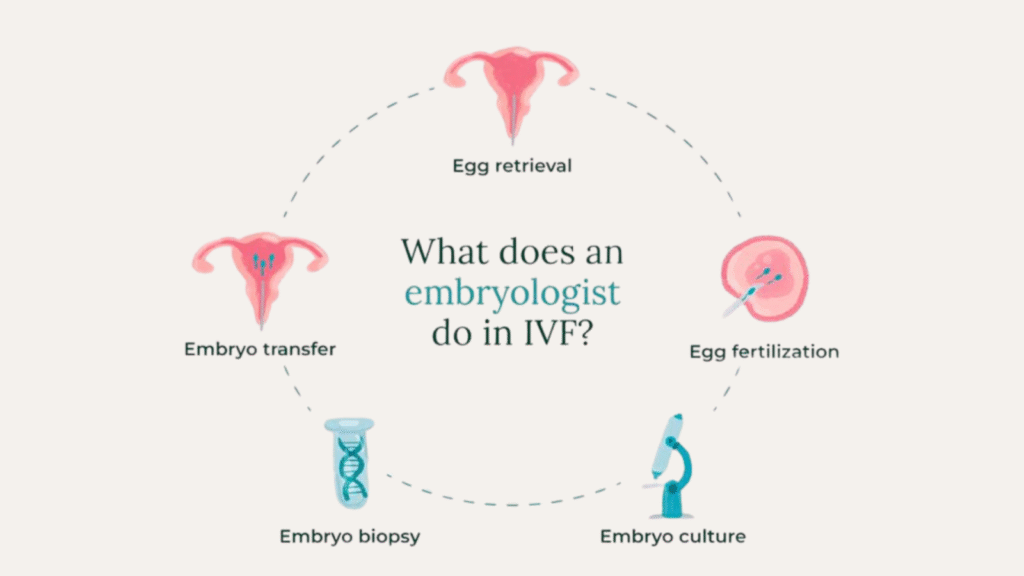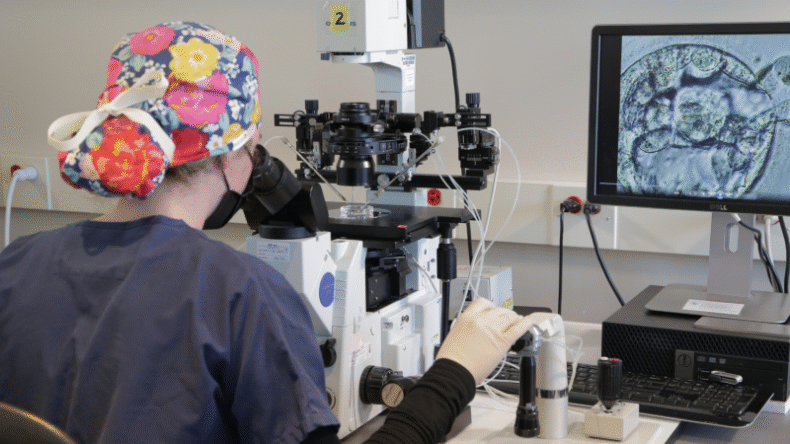
While many factors contribute to IVF success, the embryology lab plays a vital and often unseen role. It’s where science, precision, and technology come together to shape each step of your fertility journey. Behind the scenes in our state-of-the-art CCRM IVF labs are embryologists, skilled and experienced scientists who work their magic every day handling eggs, sperm, and embryos and making sure they’re healthy and ready for you when you need them.
If you’re wondering what an embryologist does during the IVF process, Joe Conaghan, Director of Science and Training at CCRM Fertility, breaks down the vital role embryologists play — from egg retrieval to embryo transfer —during your IVF cycle(s).
Egg retrieval
Your provider is the one who will retrieve your oocytes, or eggs (it’s a quick outpatient procedure under light sedation), but you’ll meet a CCRM embryologist before the procedure, who will verify your identify. During the procedure, the embryologist sits in the lab nearby and pours the follicular fluid from each follicle into a petri dish to locate and isolate each egg. Once all follicles are emptied, they’ll count how many eggs were retrieved and place them all into an incubator for safe keeping.
Egg fertilization
- Sperm preparation: The oocytes will be inseminated later that same day, but the semen sample must be processed first. Embryologists may do this, but it’s more commonly done by an andrologist, a scientist with specialized skills for examining and processing semen. This person “cleans up” the sample by isolating a small population of strong swimmers from among the dead and poorly moving sperm cells, which will be used for insemination.
- Egg fertilization: Once both sperm and egg are ready, the embryologist inseminates the mature eggs. At CCRM, we most often use a procedure called Intracytoplasmic sperm injection (ICSI) to inject a single sperm into each oocyte. This is one of the most technically challenging procedures that an embryologist will perform as they need to isolate a single tiny sperm and inject it gently into an oocyte. They’ll repeat this procedure until all oocytes are injected, after which the eggs are returned to their cozy incubator.
Embryo culture
Once the oocytes are inseminated, the embryologists monitor their development for up to a week in the IVF laboratory; this involves carefully removing the oocytes from the incubator and observing them under a microscope. The first check, to assess fertilization, is about 18 hours after ICSI. As a general rule, embryo growth is monitored for up to 5 days thereafter. By day 5, or sometimes by day 6 or 7, the embryo should have between 64 and 128 cells (it started as just one egg cell!) and should have reached the “blastocyst” stage of development.
Embryo biopsy
If you opted into preimplantation genetic testing (PGT), the embryologist will gently remove a few cells from each of your blastocysts. These samples test the embryos for chromosomal abnormalities or, in some cases, genetic conditions. In the meantime, while you await your testing results, the embryologists freeze and store the embryos that were biopsied for later use.
Embryo transfer
On the morning of your transfer, the embryologist carefully removes the embryo from the freezer and warms it. Once you’re brought back to the procedure room for your transfer, they’ll confirm your identity and then load your embryo into a catheter, which your provider will insert through the cervix into your uterus. The final step is to wash out the catheter after the procedure to make sure the embryo is no longer there and that it was transferred successfully.
It really does take a village (and an entire team of talented scientists!) to make a baby through IVF!
Learn more about CCRM’s incredible embryology team here, and book your fertility consult at CCRM today.






